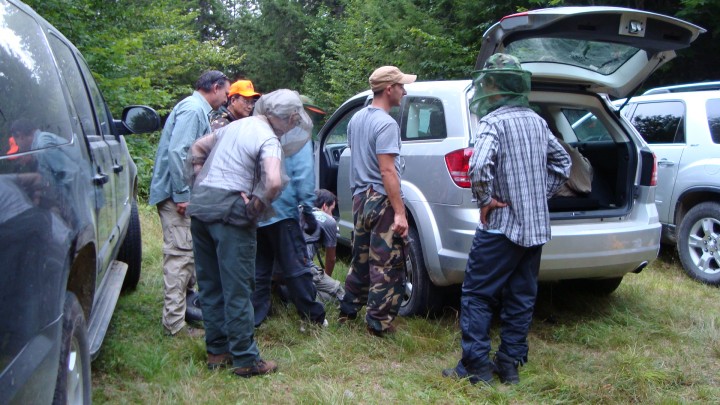From Dr. Jon Ranson:
Today we worked hard at Penobscot, finishing the plot we started yesterday and then we laid out and measured another entire one-hectare plot. I hear they made good progress in Howland, too. So we’re on track to meet our one-plot-a-day goal. It was a cooler and less humid today, but the mosquitoes still haven’t attacked in any fierce way. We’re on goal and reasonably comfortable – what more could I ask for?
We’re a bit excited over an unusual tree we found. Yesterday we tentatively identified it as a mountain maple, Acer spicatum, which is a species that I have not seen very often before. The field books all say these trees stay small, but this one is an unusually large specimen. We’ve got a lot of tree expertise here, so we went back today to take another look. We all lean hard on the A. spicatum ID, but we’re a conservative group and we won’t make claims unless we are sure we are correct. There is some uncertainty, so we’re going to confirm with the Forest Service folks. If it turns out to be a mountain maple, it’s quite possibly a state champion tree, or could even make national lists – it is just that big.

The other bit of excitement came at the end of the day. We were tired, so the group started to break up and head to the cars. I followed along a bit behind the others. When I arrived at the parking field, there was a flurry of activity. Folks were digging in their backpacks and checking their pockets. It turns out that one of the cars had a flat tire and no one could locate the keys to that car! Just as I was opening my pack to look, the word came that the keys had been found in someone’s pocket.
With keys finally in hand, Paul and Jeremy went right to work changing the flat. Most of the rest of us gathered around to watch. And yes, I guess some of us offered a bit of advice, too – why not, it’s what we do. Pretty soon someone – maybe Paul – gently wondered aloud something about how many Ph.D.s it took to change a tire. The embarrasing answer is none – all the Docs were standing around watching while the younger guys were doing all the work! Well, we laughed a bit and maybe some of us watchers shuffled our feet a little bit sheepishly, but we kept watching Paul and Jeremy work. They were doing such a fabulous job! But I do think that – maybe – we offered a bit less advice. We’re all smart enough to know where the real, useful talent lies!
Speaking of smart, I’ve mentioned before that we have a really diverse group here. I feel very lucky to work with folks with so many talents and so many different backgrounds. I’m especially gratified to see theoretical modelers out in the forest with us. These are the folks that develop mathematical representations of the forests and their interactions with remote sensing signals. Their modeling work is all done indoors, on computer. They really don’t have to ever come to the field – it’s hard, detailed, indoor type work. There are many theoretical modelers who rarely see a leaf.
We’ve got five modelers here. Not because anyone said they had to come, but because they actually enjoy learning first hand about ecosystems and trees. I’m always surprised and gratified that folks like Wenge and Guoqing, who are electrical engineers by training, want to participate on field campaigns year after year. Likewise, Sassan Saatchi, Jeremy Rubio and Yong Wang are equally field-friendly theoretical modelers. It’s wonderful to have them with us. They are a talented, enthusiastic group and add to our expertise. It’s an extra bonus that they will collect data to validate their own current models as well as to help develop the best possible algorithms for DESDynI.

Today we worked in an area of really big trees with very dense stands of small trees underneath. We’re measuring about 600 – 800 trees per hectare. The undergrowth is all less than 10 cm, so we don’t have to measure it, thank goodness! Some of the measured trees are huge – we saw a white pine that had a DBH (diameter measured 4.5 feet from the ground) of 75 cm. It was a very stately tree. The undergrowth was so thick that I was glad to have long sleeves, even in the heat. We had to push our way through very dense stands of hemlock, balsam fir and beech. It was really tough going in some spots – although it smelled fantastic. More of that natural aromatherapy.
In case I’m making this sound like all work and no play – well, it is mostly all work. But everyone gets along well, we’re enjoying working together and the scenery can’t be beat. Since we are working so fast and so well, it looks like we won’t have to work the entire weekend – we may be able to get a little time off to rest and recuperate.
Don’t tell anyone yet, but I understand that some of the local crew have connections with nearby lobstermen. They are hinting that they might be able to hook us up with a bunch of absolutely fresh, big, authentic Maine lobster at a great price. If all goes well – if we get our work done and Hurricane Bill doesn’t come knocking – I’m thinking we can put together a team-building lobster dinner out at the cabins in Howland this weekend. Everyone needs a good local meal, right? It sure sounds like it would beat Siberian fish soup.



